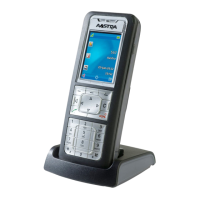Installation
154
Aastra 415/430 as of R3.2
syd-0344/1.6 – R3.2 – 09.2014
4. 8. 2 DECT radio units and cordless phones
The locations determined for the cordless phones, charging bays and radio units
during the planning phase need to be checked against the following criteria:
• Influence on radio operation
• Ambient conditions
Influences on radio operation
Radio operation is affected by the following influences:
• Outside interference (EMC)
• Obstacles in the surrounding area affect the radio characteristic
To achieve optimum conditions for radio operation, observe the following points:
• Optimum radio operation depends on the radio unit cordless phone line of
sight.
• Walls act as an obstacle to the propagation of radio waves. Losses depend on
the wall thickness, construction material and reinforcement used.
• Do not place radio units and cordless phones in the immediate vicinity of TV
sets, radios, CD players or power installations (for reasons of EMC, e.g.distribu-
tion boxes, rising power lines).
• Do not place radio units and cordless phones near X-ray installations (EMC).
• Do not place radio units and cordless phones near metal partitions.
• Observe the minimum distance requirements between adjacent radio units (see
Fig. 72).
• Minimum distance between cordless phones for fault-free operation: 0.2 m. (The
charging bays of the Office 135 can be linked using connecting strips. However,
operating several phones on interconnected charging bays can lead to malfunc-
tions.)
• Minimum distance between charging bays with cordless phones on-hook for
fault-free operation: 0.2 m.
Ambient conditions
• When installing: Ensure convection (space for ventilation).
• Avoid excessive dust.
• Avoid exposure to chemicals.

